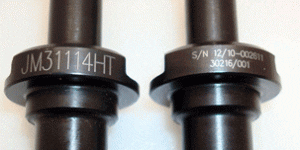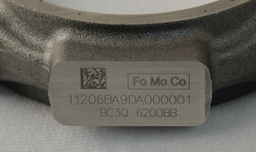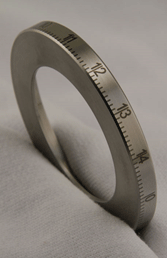Why mark automotive parts? Automotive components are marked in order to meet government, regulations, industry standards, and original equipment manufacturer (OEM) requirements for identification and trace-ability. Whatever the requirement, the mark must be permanent. Now, there are a variety of options when it comes to marking automotive components, depending on variables of production time, material and the elements a part mark must withstand over its useful life. The key is to factor those variables into matching the optimal marking method with each part. This article will guide you through selecting the right method for your automotive component.
The three considerations when choosing the method to yield a quality, permanent mark follow:
- Durability Requirements. There are 3 laser mark types (or methods): Anneal, Etch and Engrave that have various degrees of durability.
- The automotive industry uses a wide variety of materials, however, not all materials respond to every type of mark. Therefore, it is important to the mark with a type of material that will absorb the laser’s wavelength.
- Target production throughput. Understand the schedule that must be followed to ensure marked parts are produced in sufficient volume and on time.
Ignoring any one of these factors risks wasted time and materials. So, let’s break it down by mark type or method.
Anneal
Annealing is the process of using the laser to locally heat the surface of the metal so it changes color. Bright steel turns black. Aluminum turns white. This approach leaves a visible mark but does not affect the surface finish or other properties of the workpiece.
- Benefits:
- Limitation:
- Annealing is relatively slow, with the average being 10 inches per second, thus your through-put may be impacted.
- Common Uses
- Finished parts and for parts that have requirements that won’t allow you to remove material from the part, such as:
- Text
- Serial numbers
- Barcodes
- 1-dimensional logos
- Recommended Materials:
- Annealing can only be done on material containing carbon in them (eg: stainless steel)
- Finished parts and for parts that have requirements that won’t allow you to remove material from the part, such as:
Etch
Etching is the process of using the laser to remove material from a substrate. A typical etch removes a thin layer of paint, approximately .004 inches of material.
- Benefits:
- Performed in a single pass which translates to faster throughput.
- Capacity to gradually remove material and the ability to control each pass, enables precise control.
- Provides sharp contrast, allowing mark to stand out.
- Limitation:
- Some amount of material is always removed (though amount is controllable)
- Common Uses:

- Backlit Buttons
- Interior Linings
- Marking pistons
- VIN – Vehicle Identification Number plates
- Recommended Materials:
- Etching can also be done on some organic material such as Acrylonitrile Butadiene Styrene (ABS) plastic, rubber and some foam. ABS plastic is a copolymer with a shiny, impervious surface that is durable even at low temperatures. ABS is frequently used for automotive body parts, dashboards, and wheel covers. Light etching is the best method for ABS plastic as it provides a nice contrast by starting with a low power and gradually increasing that power. Careful though, because if you apply too much power when marking ABS you will start to melt the plastic.
Engrave
Deep Engraving is the process for removing a large amount of material to make a highly durable mark.
- Benefit:
- Mark is highly durable; giving you the capability to create a mark that will last the lifetime of the part.
- Limitation:
- Similar to an etch but to a greater extent, some amount of material is always removed.
- Common Uses:
- 2D Matrices
- VIN – Vehicle Identification Number plates
- 2-dimensional logos.
- Recommended Materials:
- All metals can be engraved, however, some materials like gold, copper, and brass are harder to engrave due to the material make up. However, note that highly reflective metals can be challenging to engrave.
- Some organic material such as ABS plastic, rubber and some foam.
Conclusion
When it comes to marking automotive components, understanding the best method for your part is essential. The next time you mark an automotive component, be sure to consider the material, your throughput requirements and the durability requirements to select the method that best fits your needs.
Have more insights on marking automotive components or some thoughts about these? Join the conversation and leave your comment below.
Vytek has solved thousands of unique application challenges over its 26-year history of manufacturing CO2 and Fiber lasers.















